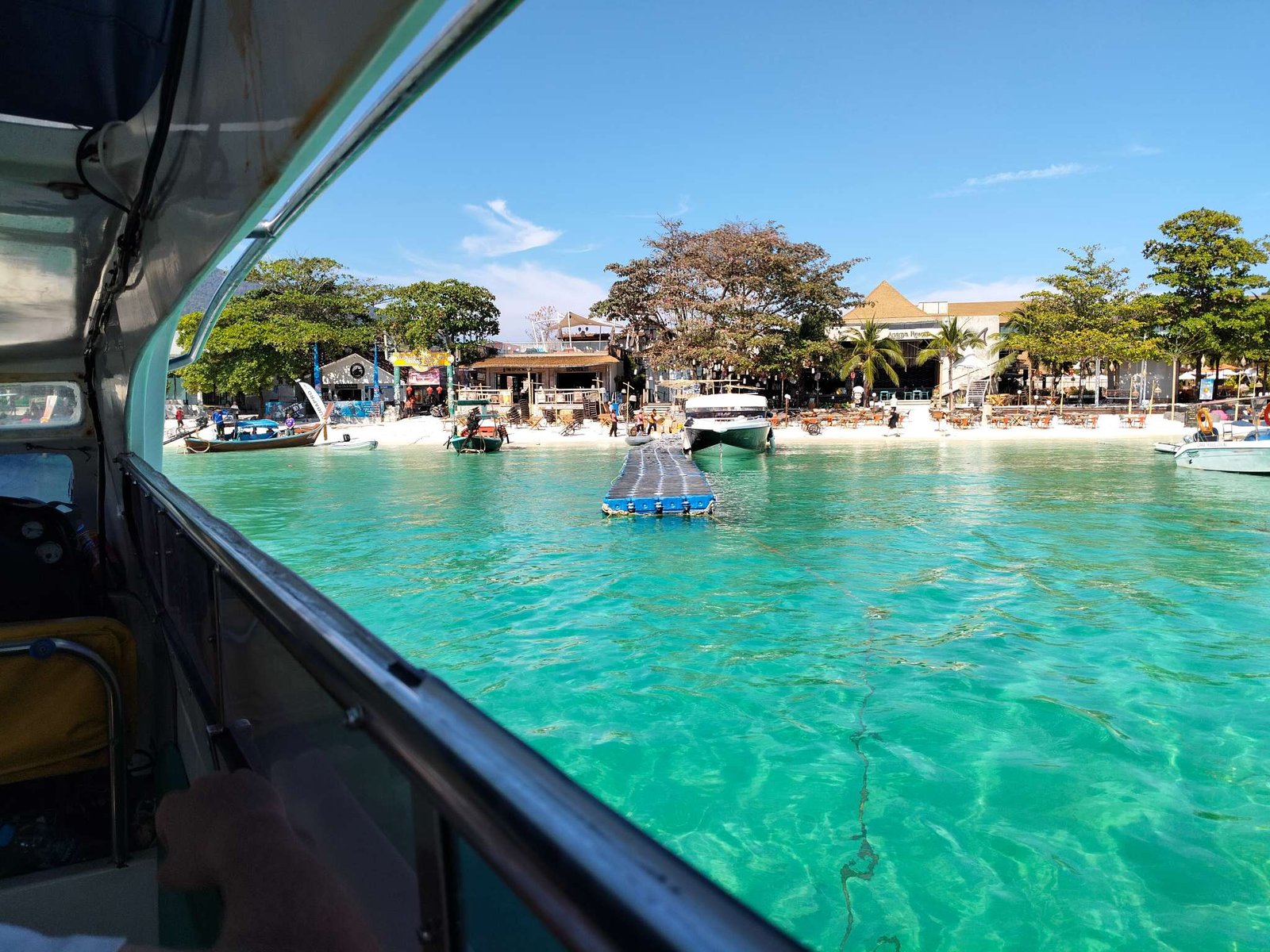How to avoid seasickness on a ferry
Ah, the joys of sailing. The cool breeze, the sound of waves, the wide open horizon. What could be better? Well, for some of us, seasickness can quickly ruin the experience of a peasant ferry trip.
Sea sickness, also known as motion sickness((Motion Sickness – Cleveland Clinic)), is a common condition that affects many people when traveling on ferries or long trips on the open sea. It's an uncomfortable condition that can make you feel nauseous, dizzy, and generally unwell.
Fortunately, there are things you can do to prevent or lessen the effects of sea sickness. On a ferry, for instance, there are best places to sit to avoid seasickness.
Best place to sit on a ferry to avoid seasickness
The middle of the ferry is typically the area with the least amount of motion. This is because the center of the vessel is closer to its center of gravity, where the movement is less exaggerated compared to the front (bow) or rear (stern). Being lower in the vessel also reduces the sensation of motion because the lower decks experience less vertical movement compared to the upper decks.
Seasickness is often caused by the brain receiving conflicting signals from the inner ear (which senses motion) and the eyes (which may not detect the same motion, especially if you're inside and can't see outside). By sitting in the middle and lower part of the ferry, you minimize the intensity of the motion your inner ear senses, which can reduce the likelihood of seasickness.
However, this isn't the best place yet
You probably heard it before: “Looking at the horizon helps against seasickness.” this is true, however be sure not to stare intently, you need to be glancing at the horizon and avoid over-focusing. From the middle, lower part of the ferry you can't generally see the horizon, so you can also take a windows seat here, be sure not to take a position at the front but at the side of the vessel.
Check the featured image of this blogpost to see which are the best spots on an average ferry. The bottom-floor seats in full green are best!
The hidden risk of sitting near seasick passengers
You have to know though, that these areas often attract other passengers who are also prone to seasickness. Did you know that sitting near someone who is already seasick can actually increase your own chances of feeling unwell? The sight, sounds, or even the smell of someone experiencing nausea can trigger a similar response in you, making it harder to keep your own seasickness at bay.
How to prepare against seasickness before your ferry trip
The best way to prevent seasickness is to be as prepared as possible before your ferry ride. Here are some tips to help you stay comfortable and nausea-free:
- Try sleeping through your ferry trip; plan this with your regular sleep timing, and ensure you have a quiet spot and things to block sound and light when you arrive on the ferry.
- Fresh air and Fresh Wind can alleviate and lessen seasickness. Only go outside if it's 100% safe, of course.
- The oldest and best-known tip: Avoid drinking alcohol or eating heavy meals before the trip. Also, avoid spicy meals the day before: your stomach needs to be as relaxed as possible.
- Use wristbands like the ones you also use when you go jogging. They tend to help: various specialized anti-seasickness products for sale are supposed to work. However, a normal wristband would do. (this tip however is controversial, read tip 7 for this)
- Find a seat in the middle of the ferry; the lower you are, the better. So stay low (not the upper deck) and sit in the middle.
- But.. Window seats tend to be better (a tip that might collide with the seat in the middle of the ferry) if you keep your eyes on the horizon. Seeing the horizon allows you to calibrate your internal equilibrium constantly. Don't stare at the horizon, however: You want to glance at the horizon, keeping it in sight continually. If you can’t look at the horizon, keep your eyes closed. This will reduce the conflicting signals between your eyes and inner ear.
- Mythbusters once confirmed you can cure seasickness by taking a ginger pill. ((Mythbusters: Ginger Pill)) In this same episode, they also conclude that these wristbands mentioned in tip 4 are useless. Ginger, however, is a good way to heal motion sickness.((Ginger to prevent motion sickness – Pupmed Clinical Trial))
- When you arrive on the ferry: Avoid strong and smelly places (places with food smells, heavy perfume or petrol, etc.) If you by accident end up no a seat with strong odors: make sure you change seats.
- You want to avoid your body overheating, so stay out of direct sunlight and continually sip water to stay hydrated. As you get closer to the equator, the sun gets stronger and if you aren’t keeping liquids in you, dehydration can bring on symptoms of seasickness.
- Don’t use binoculars, or cameras or read for an extensive length of time. Simply avoid staring at things that your brain would usually consider stable. This will only make your symptoms worse.
- Eat less. Drink warm drinks. (Tip from a local captain we've gotten when we were seasick ourselves)
- Move away if you see (or smell) someone else getting seasick. It's a contagious thing and you should move away quickly (in a respectful manner, of course).
- A wild sea can have a huge impact on seasickness. Check the route you are taking and see if this is a wild season or not. Of course, you can't completely control this, but it's better to avoid a wild sea if you are really scared or have bad seasick experiences.
- Seasickness Medications: Commonly used medicines are diphenhydramine (Benadryl), dimenhydrinate (Dramamine), and scopolamine. They tend to work well, but we would only go for this as a last resort.
- Motion sickness patches: Motion sickness patches, such as scopolamine (Transderm Scop), are applied behind the ear and are effective in preventing motion sickness.
- Try to face forward with your seat; don't fall for the seats that face the wrong way.
- Make sure to get plenty of sleep the night before.
- Grab a vomit bag BEFORE you need one, or better, take one with you from your home.
- Sit in an area with fresh air and good ventilation. Avid sailers always pick the place with the best ventilation for a ferry trip.
The Natural Remedies against Sea Sickness

There are several natural remedies you can try to help lessen the effects of seasickness, two of them are already explained above, however, there are actually 3 of them. If you simply bring along on your trip: Peppermint / Ginger Tea or Ginger Candy and Acupressure Wristbands, you are 80% safe.
- Ginger: Ginger is known for its anti-nausea properties and can help reduce feelings of nausea. You can try taking ginger capsules, drinking ginger tea, or eating ginger candy to help with sea sickness.
- Peppermint: Peppermint has been found to help calm the stomach and ease feelings of nausea. You can try drinking a cup of peppermint tea or sucking on peppermint candy.
- Acupressure: Applying pressure to specific points on the body, such as the wrists and temples, can help reduce feelings of nausea. You can use acupressure bands or simply press your fingers on the pressure points.

When you are on the ferry, and you feel Seasickness coming
It's important to immediately go for fresh air. Then hydrate a little to keep the body hydrated, then quickly pick up some peppermints and ginger candies and try to fall asleep.
Conclusion: Fighting Seasickness on Ferries
You are not the first (and the last) one to fight seasickness on a ferry. On some connections (crossing the Tasman sea for instance) there is much more to worry about than on a short crossing from Calais to Dover. However, with the right preparation and knowledge, you can make your ferry ride a pleasant one. By following the tips outlined in this article, you'll be well on your way to sailing smoothly on your next voyage. So don't let seasickness spoil your next adventure – prepare yourself, and you'll be sure to have a wonderful time!
Meet Jochem Vroom – Online Investor, Digital Strategist and Experienced Ferry Traveler. When he's not busy running his businesses, Jochem loves nothing more than exploring new destinations by sea. At FerryGoGo, Jochems' primary mission is to safeguard the integrity and excellence of our content and website. Jochem achieves this by meticulously verifying reviews, routes, and maintaining continuous communication with ferry operators. This commitment ensures the authenticity of the content featured on FerryGoGo.com.







We can all agree those wristbands are fake right?
Best way is to be at the front of the ferry top front deck was good and top middle deck being at the back definitely will get you sick I don’t know if it’s the vibration of the motors because once the motors cut out I felt a calm feeling I’d definitely say it was the vibration of the motors
What is your opinion on the patches? (Scopolamine patches?)
@De Jaeger
Research is not that positive on these patches:
https://www.healthline.com/health/scopolamine-patch-side-effects
” However, in rare cases, serious side effects can occur. ”
” dry mouth
sweating
drowsiness
dizziness
sore throat
dilated pupils ”
This is how to attach them the right way (if you still plan on using them)
” How to apply a scopolamine patch properly
– Carefully wash and dry the area behind your ear.
– Please make sure the area behind your ear has no cuts, irritation, bumps, or tenderness.
– Carefully remove the patch from its packaging, making sure not to touch the adhesive side with your fingers.
– Place the patch on your skin with the adhesive side pressed down.
– Wash your hands with soap and water. “
Sucking on an ice cube is magic. Takes away that initial urge to vomit.
[…] in mind that the outbound ferry is not very comfortable. If you get seasick easily (read more about how to avoid seasickness on a ferry) you can travel most of the way by train and only take the short final stretch by […]